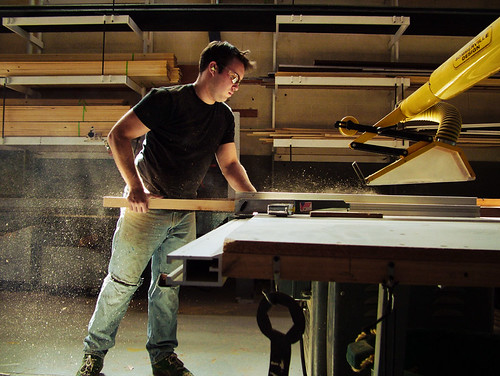I found a great post at ToolCrib about the ten most dangerous woodworking tools. What makes it great is that it attempts to survey what woodworkers think are the most dangerous tools in the shop, and also lists the statistics about the most common injuries from woodworking shops. Often, what we think are the most dangerous tools does not always coincide with where the greatest hazards lie. This is especially true when you look at your own individual experience; if you witness someone chew their fingers up on a router, you will be more biased to believe a router is the most dangerous tool ever. This can also be the case if you work in a shop with poorly maintained tools. A table saw which shakes and wobbles is much more dangerous than a well-maintained table saw with multiple safety features.

The list also takes into account the type and severity of injuries you can incur. In my own experience, by far, the vast majority of my injuries come from slicing my fingers or hands on box cutters, razor blades, and even sharp edges of certain materials. While highly common, they are easily taken care of with hot, soapy water, antibiotics, and a bandaid. They are hardly debillitating, and barely slow me down. A jointer, on the other hand, can chew your entire hand into hamburger in a fraction of a second. While much less likely, this type of injury is obviously much more severe.
This brings up one of the other important points of this list. You know a jointer is highly dangerous, so you pay more attention to your safety. You use it less often, so there’s less of a chance to be injured by it. A knife, on the other hand, is used many times throughout the day. You know it is less likely to severely injure you, so you may pay less attention to your safety while using it.All that being said, I would say the top power tool on their list is also the one I’ve seen the most injuries on: the table saw. I nicked my thumb down to the bone on a table saw when I was 14. I’ve seen kickbacks that sent guys to the hospital. Once, a carpenter was ripping strips out of a full sheet of plywood. It binded in the blade, and a strip flew out of the back of the table saw and hit a guy that was working nearly twenty feet away. It broke into three pieces against his back, leaving a horrible looking bruise that lasted for weeks. It flew back with so much force, that even after hitting the guy and breaking apart, it still continued flying backwards and hit the concrete wall fifty feet away so hard that the noise caused everyone in the shop to stop what they were doing and look up.
I think it’s vital to teach workshop safety to everyone who uses tools in your shop. You need to instill enough fear in them that they treat the tools with respect without totally paralyzing them against ever using the tools. I started off young; I was lucky enough to take shop in junior high school, and I took it again in high school where I built a bookcase. It’s so much easier to scare proper safety into a kid when he’s only 12; likewise, a person who was able to safely work in a woodshop as an adolescence will have enough confidence to work in one as an adult.
The most important thing is to know when what you’re doing is safe or not. Most injuries happen when a carpenter thinks, “I’ve never done it this way, but just this once…” Even an accomplished woodworker knows when to grab a buddy to help maneuver something through a table saw, or spend the time constructing a jig to hold everything in place while running a router. It’s usually the inexperienced person who thinks good carpentry means jumping in as quickly as possible with blades spinning to prove they can do it without assistance.
Unfortunately, in the world of theatre, we can’t always have the ideal training situations. There are a lot of jobs, especially with summer stock and smaller theatres, where an inexperienced person is given the keys to a shop and left to figure everything out on their own. If you are a student interested in props, even if you are absolutely sure you want to do only soft-goods or crafts, you should take the time to work through a carpentry shop. Even if you only use each tool once, at least you were able to learn how to use it properly. Take a stagecraft class, or work on the set crew for one show. Props is a world where you need to know how to do everything. Even if you don’t do carpentry, chances are, there will be a time where you need to cut a piece of wood.




